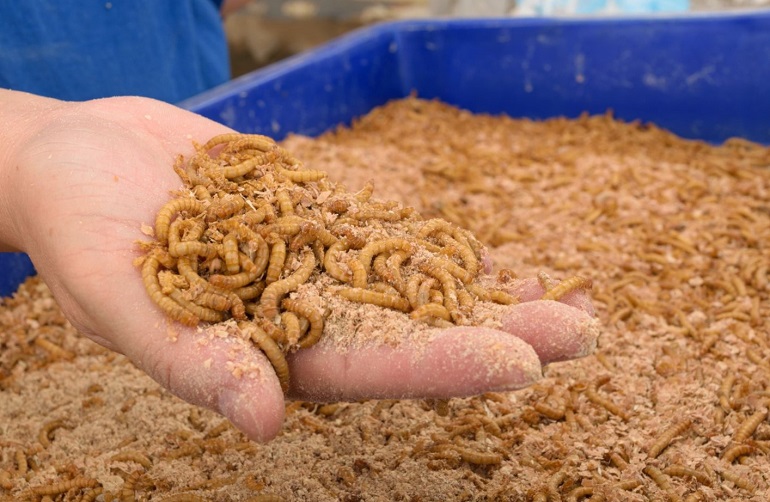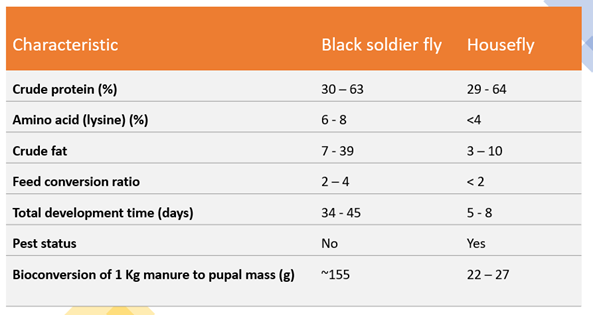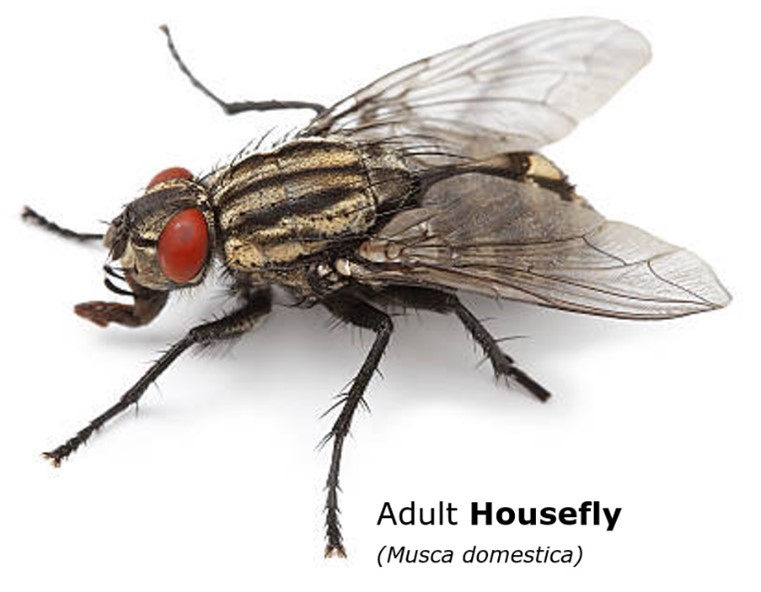Choosing the right species for mass production of insects as animal feed

This post is also available in:
This post is also available in:
![]() Español (Spanish)
Español (Spanish) ![]() Français (French)
Français (French)
Edible Insect Production

According to the United Nation’s projection, close to 10 billion people will be present in the world by 2050. Economic growth will result from population growth as more people demand and supply goods. To meet the ever-increasing and ever-changing demand for and supply of animal-derived food products while reducing the negative effects of their production on the natural environment, innovative and sustainable technologies are required. One option is edible insect production using organic streams to produce insect protein for farmed animals.
As an alternative to the increasingly scarce and costly fishmeal and soy meal, whose production is no longer sustainable, edible insects have quickly gained popularity as sources of protein and other nutrients in aquaculture and livestock feed due to their excellent nutritional value (Figure 1). Read more about Insect Meal in Sustainable Animal Feed.

What are the benefits of edible insect production?
Edible insects are rich in iron, vitamin B12, zinc, essential amino acids, omega-3 and omega-6 fatty acids, and antimicrobial properties. Including insect meal in animal feed could reduce agricultural land and water use, and improve disease prevention and management. Ecologically, the ability of insects to degrade organic substrates underpins a major benefit in terms of sustainability, as it could reduce environmentally damaging contamination.
The fact that insect larvae can process organic waste into useful biomass is now seen as having a commercial potential and provides a source of livelihood, especially for resource-limited groups. Reusing organic waste to feed insect larvae is an appealing strategy for the food value chain in the context of a sustainable circular economy. Moreover, insect production uses fewer resources while accumulating healthy fats, proteins, and minerals. Their production creates fewer greenhouse gas emissions than beef, pork, or chicken farming. Compared to conventional livestock, insects have a lower feed-to-protein conversion ratio. Significant opportunities exist in regions where organic solid waste accounts for a disproportionately high share of municipal solid waste.
Which insect species?
While several insect species are being reared, the use of Dipteran larvae seems to be the most cost-effective method of extracting insect protein for use in animal feed. Moreover, the ability to bio-convert organic waste is viewed as particularly promising for insect species such as the housefly (Musca domestica), yellow mealworm (Tenebrio molitor) and black soldier fly (Hermetia illucens). The yellow mealworm is also reared for human food, therefore their production using organic waste is limited. Interestingly, insects show considerable variation in their food preferences and exploit food sources with widely varying attributes including nutrient quality. Insect protein can be produced cheaply by selecting one species or the other and organic solid waste as a rearing substrate.
Selecting an ideal insect species
Some key factors to consider when selecting an ideal insect species for mass production include the species’ biology, rearing substrates (particularly the ability to degrade organic waste), growth, reproduction, environmental impact, nutritional quality, and health aspects of consumption by animals. Here, two insect species: black soldier fly larvae and houseflies that extensively consume organic waste and are considered for animal feed, will be compared to guide their selection for mass production and inclusion in animal feed formulations (Figure 1; Table 1).
Black soldier fly, Hermetia illucens

The black soldier fly (BSF), Hermetia illucens is common in the tropics and subtropics where temperatures are relatively high and support its development. In its life cycle, BSF goes through five main stages: egg, larva, pre-pupa, pupa, and adult. During harvesting, hand-collecting pre-pupa can be avoided because they can leave the substrate and move to clean, dry spots to pupate (self-harvesting).
Waste conversion, growth, and reproduction: BSF larvae can grow on a wide range of organic materials and agro-industrial by-products and transform them into valuable insect biomass. The survival rate of BSF larvae ranges between 80 – 99% when reared on spent grains, pig manure, chicken manure, and cow manure. Larvae are ready for harvest in about two weeks and the complete cycle (egg – adult) takes about 40 days (Table 1). Interestingly, adults do not constitute a nuisance because they are not attracted to human habitats or foods, and, unlike other fly species, BSF is not a disease vector. Adult BSF can lay up to 900 eggs, which hatch in 3 – 4 days at 25 – 30 ̊C. Temperature and relative humidity (70%) play important roles in their growth and development.
Waste reduction: It is common for BSF larvae to eat twice their body weight in a day and can potentially reduce food waste by 60 – 80 %. The larvae have the potential to degrade approximately 30 tons of food waste per day, producing approximately 1000 kg/day of residue that can be used as an organic fertilizer and about 2300 kg of prepupae per day, resulting in a final compost with well-balanced nutrient content. By using waste like food scraps and manure as rearing substrates, BSF larvae can reduce the environmental impact of conventional protein-rich feed ingredients. When applied globally, BSF technology can cut pollution risks by as much as half or more.
Nutritional value: Depending on the rearing substrate, BSF larvae are rich in protein, fat dry matter (Table 1), and an amino acid profile similar to fishmeal. The BSF larval fat contains 58-72% saturated and 19-40% mono- and polyunsaturated fatty acids. BSF larvae are also rich in minerals such as manganese, iron, zinc, copper, phosphorus, and calcium as well as bioactive compounds such as chitin and antimicrobial peptides with high agricultural, biotechnological, and medical potentials.
Contamination: BSF larvae raised on agro-industrial waste have lower levels of chemical contaminants like veterinary medicines, pesticides, heavy metals, dioxins, polychlorinated biphenyls, polyaromatic hydrocarbons, and mycotoxins than the European Commission, World Health Organization, and Codex Alimentarius recommend. However, caution must be ensured against larval cadmium bioaccumulation.
Table 1. Nutritional and growth characteristics of the black soldier fly and housefly

Housefly, Musca domestica

The housefly, Musca domestica, a well-known pest and vector of pathogens is today mass-produced using decaying plant matter and animal manure, converting them into protein and fat. It goes through four main developmental stages including egg, larva, pupa, and adult. The larva stage is targeted for inclusion in animal feeds.
Waste conversation and pest management: The high reproductive rate, short life cycle (Table 1), low maintenance and ease of rearing using organic waste benefit industrial-scale breeding programmes. Like the BSF, housefly consumes a wide range of organic wastes and feeds well on chicken and pig manure, reducing them, but their larval yield is lower than in the BSF larval substrate conversion. The potential of the housefly to feed on a wide range of substrates constitutes a sustainable option for valorising these materials, producing high-value products by using manure and other organic waste as a substrate for intensive insect biomass production. However, their ability to transmit pathogens limits their use for on-farm waste management and protein production. However, housefly rearing can be accomplished in controlled rearing rooms that are designed to prevent escape and provide aeration, with a temperature of 25-32 °C and a relative humidity of 60-70%.
Reproduction: The adult housefly colony must provide enough eggs to efficiently maintain a mass-rearing plant. A female adult housefly can lay 10-15 eggs per day, bringing the total egg production in the reproductive cycle to about 500 eggs per female, with the number increasing to over 1000 eggs. The oviposition substrate is one of the factors influencing egg production, and manure with high ammonia content is the best substrate for housefly female oviposition. Another factor is adult density, whereby it is recommended to rear houseflies at high densities.
Nutritional value: Pupae and larvae of the housefly produce animal feed or secondary products like biodiesel and biologically active compounds, while waste residues can be used as fertilisers in crop production. Housefly larvae can reduce waste by up to 80% and generate nutrient-rich larvae for animal feed and residue for soil nutrient improvement. Housefly larval meal has a crude protein content of up to 64% and a crude fibre of up to 10% (Table 1). The nutritional content is affected by diet, age of larvae at harvest, drying method, and method used to calculate protein content.
Pathogen contamination: Housefly larvae or pupae in the feed may carry pathogens. The flies spread helminthic eggs like Escherichia vermicularis, protozoa cysts and trophozoites like E. histolytica, bacteria like E. coli and Salmonella, and viruses and fungi.
Concluding remarks
The house fly develops more rapidly, has a higher feed conversion ratio, the highest crude protein content, and requires less knowledge of reproduction and adult biology than the BSF. Housefly larval yield and survival rate are low when fed animal manure, making it less promising for biodegrading organic waste than the BSF. In addition, adult houseflies are more likely than adult BSF to transmit pathogens. On the other hand, BSF larvae more efficiently exploit a wider range of organic wastes, converting them into useful insect biomass than housefly larvae. Self-harvesting BSF pre-pupae reduces the need for manual collection or separation from residual rearing substrate. In contrast to houseflies, adult BSF is not considered pests, and their population growth poses no environmental or health risks. Generally, both insect species have the potential to be beneficial in large-scale production systems as farmed insects. This article highlights key aspects to consider in choosing one insect species over the other or both.
Relevant literature
Barragan-Fonseca, K. B., Dicke, M., & van Loon, J. J. A. (2017). Nutritional value of the black soldier fly (Hermetia illucens L.) and its suitability as animal feed – a review. In Journal of Insects as Food and Feed. https://doi.org/10.3920/JIFF2016.0055
Bosch, G., van Zanten, H. H. E., Zamprogna, A., Veenenbos, M., Meijer, N. P., van der Fels-Klerx, H. J., & van Loon, J. J. A. (2019). Conversion of organic resources by black soldier fly larvae: Legislation, efficiency and environmental impact. Journal of Cleaner Production. https://doi.org/10.1016/j.jclepro.2019.02.270
Charlton, A. J., Dickinson, M., Wakefield, M. E., Fitches, E., Kenis, M., Han, R., … & Smith, R. (2015). Exploring the chemical safety of fly larvae as a source of protein for animal feed. Journal of Insects as Food and Feed, 1(1), 7-16. https://doi.org/10.3920/JIFF2014.0020
Chia, S. Y., Tanga, C. M., Osuga, I. M., Cheseto, X., Ekesi, S., Dicke, M., & van Loon, J. J. (2020). Nutritional composition of black soldier fly larvae feeding on agro‐industrial by‐products. Entomologia Experimentalis et Applicata, 168(6-7), 472-481. https://doi.org/10.1111/eea.12940
Chia, S. Y., Tanga, C. M., Osuga, I. M., Mohamed, S. A., Khamis, F. M., Salifu, D., … & Ekesi, S. (2018). Effects of waste stream combinations from brewing industry on performance of Black Soldier Fly, Hermetia illucens (Diptera: Stratiomyidae). PeerJ, 6, e5885. https://doi.org/10.7717/peerj.5885
Čičková, H., Newton, G. L., Lacy, R. C., & Kozánek, M. (2015). The use of fly larvae for organic waste treatment. Waste Management, 35, 68-80. doi:10.1016/j.wasman.2014.09.026
Cullere, M., Tasoniero, G., Giaccone, V., Miotti-Scapin, R., Claeys, E., De Smet, S., & Dalle Zotte, A. (2016). Black soldier fly as dietary protein source for broiler quails: Apparent digestibility, excreta microbial load, feed choice, performance, carcass and meat traits. Animal. https://doi.org/10.1017/S1751731116001270
Gligorescu, A., Fischer, C. H., Larsen, P. F., Nørgaard, J. V., & Heckman, L. H. L. (2020). Production and optimization of Hermetia illucens (L.) larvae reared on food waste and utilized as feed ingredient. Sustainability, 12(23), 9864. https://doi.org/10.3390/su12239864
Hawkey, K. J., Lopez-Viso, C., Brameld, J. M., Parr, T., & Salter, A. M. (2021). Insects: a potential source of protein and other nutrients for feed and food. Annual review of animal biosciences, 9, 333-354. https://doi.org/10.1146/annurev-animal-021419-083930
Issa, R. (2019). Musca domestica acts as transport vector hosts. Bulletin of the National Research Centre, 43(1), 73. doi:10.1186/s42269-019-0111-0
Lange, K. W., & Nakamura, Y. (2023). Potential contribution of edible insects to sustainable consumption and production. Frontiers in Sustainability, 4.
Oonincx, D. G. A. B., van Huis, A., & van Loon, J. J. A. (2015). Nutrient utilisation by black soldier flies fed with chicken, pig, or cow manure. Journal of Insects as Food and Feed. https://doi.org/10.3920/jiff2014.0023
Ortiz, J. C., Ruiz, A. T., Morales-Ramos, J., Thomas, M., Rojas, M., Tomberlin, J., . . . Jullien, R. (2016). Insect mass production technologies. In Insects as sustainable food ingredients (pp. 153-201): Elsevier.
Pastor, B., Čičková, H., Kozánek, M., Anabel, A. M., Takáč, P., & Rojo, S. (2011). Effect of the size of the pupae, adult diet, oviposition substrate and adult population density on egg production in Musca domestica (Diptera: Muscidae). European Journal of Entomology, 108(4), 587-596. doi:10.14411/eje.2011.076
Rumpold, B.A., Klocke, M., Schlüter, O. (2016). Insect biodiversity: Underutilized bioresource for sustainable applications in life sciences. Reg. Environ. Change, 17, 1445–1454. doi:10.1007/s10113-016-0967-6
Salomone, R., Saija, G., Mondello, G., Giannetto, A., Fasulo, S., & Savastano, D. (2017). Environmental impact of food waste bioconversion by insects: Application of Life Cycle Assessment to process using Hermetia illucens. Journal of Cleaner Production. https://doi.org/10.1016/j.jclepro.2016.06.154
Surendra, K. C., Olivier, R., Tomberlin, J. K., Jha, R., & Khanal, S. K. (2016). Bioconversion of organic wastes into biodiesel and animal feed via insect farming. Renewable Energy. https://doi.org/10.1016/j.renene.2016.03.022
United Nations Department of Economic and Social Affairs, Population Division (2022). World Population Prospects 2022: Summary of Results. UN DESA/POP/2022/TR/NO. 3.
Van Huis, A., & Tomberlin, J. K. (2016). Insects as food and feed: from production to consumption. Wageningen Academic Publishers.
Van Huis, A., Oonincx, D. G. A. B., Rojo, S., & Tomberlin, J. K. (2020). Insects as feed: house fly or black soldier fly?. Journal of Insects as Food and Feed, 6(3), 221-229. https://doi.org/10.3920/JIFF2020.x003
Van Huis, A., Van Itterbeeck, J., Klunder, H., Mertens, E., Halloran, A., Muir, G., & Vantomme, P. (2013). Edible insects: future prospects for food and feed security (No. 171). Food and agriculture organization of the United Nations.








































































